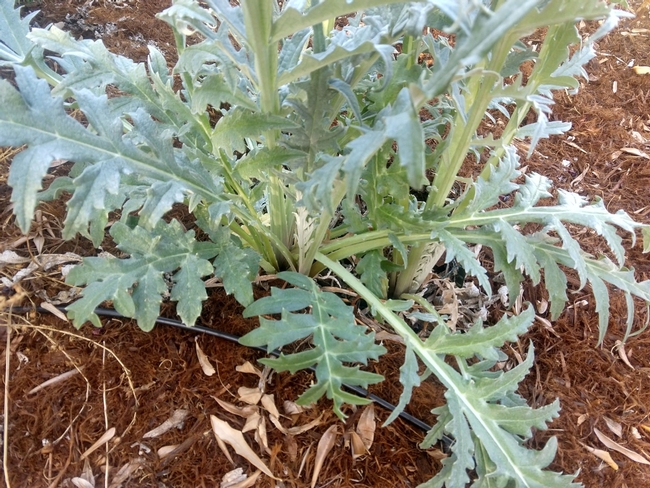Advice for the Home Gardener
from the MGCC's Help Desk
artichoke plant
MGCC Help Desk Response: Thank you for contacting the UC Master Gardener Program Help Desk regarding your question about reducing the amount of rosettes on your artichoke plants. I was unable to find any UC research to indicate that thinning the rosettes would contribute to an increase in the production of artichokes.
The information I read about improving crop and taste had to do with cultural practices such as adding organic matter and ensuring proper watering for the plant. Artichoke plants do best in a 6.5-8 pH soil. They are heavy feeders and benefit from lots of organic matter. They like good drainage and generally do best in sun to partial shade. They require protection from prolonged frost. The pictures of your artichoke plants show that your plants look quite healthy.
There was one article I read through the UC Davis vegetable research that suggested during harvest season that the old bearing stalks could be removed to encourage the development of new shoots. The stalk was removed below the ground. The process was called “stumping”.
It was also interesting to read in several different UC resources that generally the life of an artichoke plant is about 5 years because the root area becomes crowded and the plants lose vigor.
If you would like more information about growing artichokes, below is a link to an article written about growing artichokes by the Sonoma County Master Gardeners.
http://sonomamg.ucanr.edu/Food_Gardening/Feature_Vegetables/Artichokes/
Good luck with your artichoke crop!
Help Desk of the UC Master Gardener Program of Contra Costa County (JRB)
Notes: Contra Costa MG's Help Desk is available almost year-round to answer your gardening questions. Except for a few holidays (e.g., last 2 weeks December), we're open every week, Monday through Thursday for walk-ins from 9:00 am to Noon at 2380 Bisso Lane, Concord, CA 94520. We can also be reached via telephone: (925) 608-6683, email: ccmg@ucanr.edu, or on the web at http://ccmg.ucanr.edu/Ask_Us/. MGCC Blogs can be found at http://ccmg.edu/HortCoCo/ You can also subscribe to the Biog.